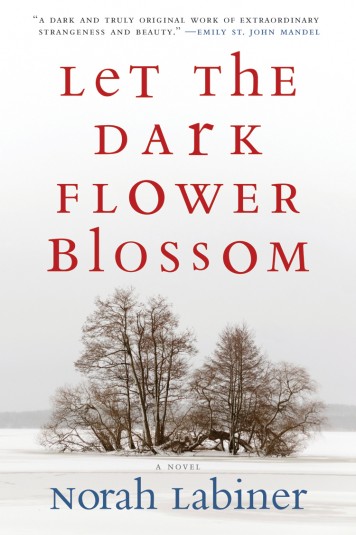Review By Lindsey Grudnicki
How far are you willing to go to tell a good story?
Would you destroy your friends? Would you destroy yourself?
What would you sacrifice to write the perfect tragedy?
Norah Labiner’s Let the Dark Flower Blossom contemplates what dark power exists at the heart of storytelling and questions the lengths that a writer will go to in order to have a tale worth telling.
Set in the snow-covered woodlands and windy cities of the Midwest, Labiner’s book begins with the announcement that Roman Stone, a famous novelist, has been murdered. Yet rather than search for clues at the scene of the crime or follow in the footsteps of those investigating the incident, the author takes on an unusual journey through Roman’s past. Jumping between the memories of his college friends, twins Sheldon and Eloise Schell, and the recollections of Susu, a young woman with a mysterious connection to all three of them, Labiner masterfully unveils the lies and violent history that has brought Roman – and those who close to him – to the final act of the tragedy he crafted.
A middle-aged widower living on an island in Lake Superior, Sheldon Schell is “also a novelist” who responds to Roman’s death by confronting the terrible secrets they once shared. Determined to write “a true story,” Sheldon allows his thoughts to wander into the shadowed, blood-stained corners of his mind in order to piece together the puzzle of Roman’s life, fame, and untimely demise. “He wrote of fate and then fell to it,” Sheldon surmises before leading readers through the winding channels of memory. Though he tries to serve as a reliable narrator, the events that Sheldon must explain are those that he has attempted to forget; the images he gives are initially blurry, with faces blanked out and details missing, but as the story unfolds he becomes more and more obedient to the “first rule of storytelling” – “Be true.”
As her brother struggles to conjure up his and Roman’s troubled past, Eloise battles to fight off the influence that Roman still bears over her present. He is a ghost, but the knowledge that he knew the darkest, most intimate details of her life and used them in his writing hangs over her existence, making her doubt her own identity and choices. “This is how the gods will make you mad,” she muses, “They will make you doubt your own reliability. As a witness to your life.” Without Roman to construct the ending of her story, Eloise must rediscover herself and reclaim her past in order to move forward.
Labiner gives each narrator their own distinct style, ranging from Sheldon’s fractured, poetic sentences to the rambling stream-of-consciousness in which Susu describes Roman’s final months. Their voices are often frantic and always haunting, building the suspense and carrying readers to the inevitable moments of revelation. Labiner is both a skilled poet and elegant prose writer, displaying both talents as she alternates between her various narrators.
Part way through the novel, Susu asks whether stories “keep us distract us save us for one more moments one more minute from facing the thing that we fear? Do they distract us from some ancient terrible truth?” This, it seems, is Norah Labiner’s larger question, and the one that she leaves with her readers. Our stories are products of our lives and surroundings; our memories, our audience, our own needs to confess what lies buried within us mold and shape them into the final form we present to the world. But stories, Labiner suggests, possess the ability to destroy as much as they have the power they have to free us. Each of her characters is “a storyteller in love with a story,” and it corrupts the human relationships they are desperate to foster. Those who manipulate language may have grand narratives, but “all the poetry in the world cannot save” them from emptiness, guilt, or hatred.
The complex characters, the oppressive sense of fate, the vivid winter landscape, and, most of all, the challenging questions about the nature of storytelling lingered long after I finished Let the Dark Flower Blossom. It is undeniably a novel for writers, and a tale to be read curled up, surrounded by your own papers and the stories they hold, as the snow falls in the background.
Let the Dark Flower Blossom is available from Coffee House Press: http://coffeehousepress.org/shop/let-the-dark-flower-blossom/.



